(more photos below)
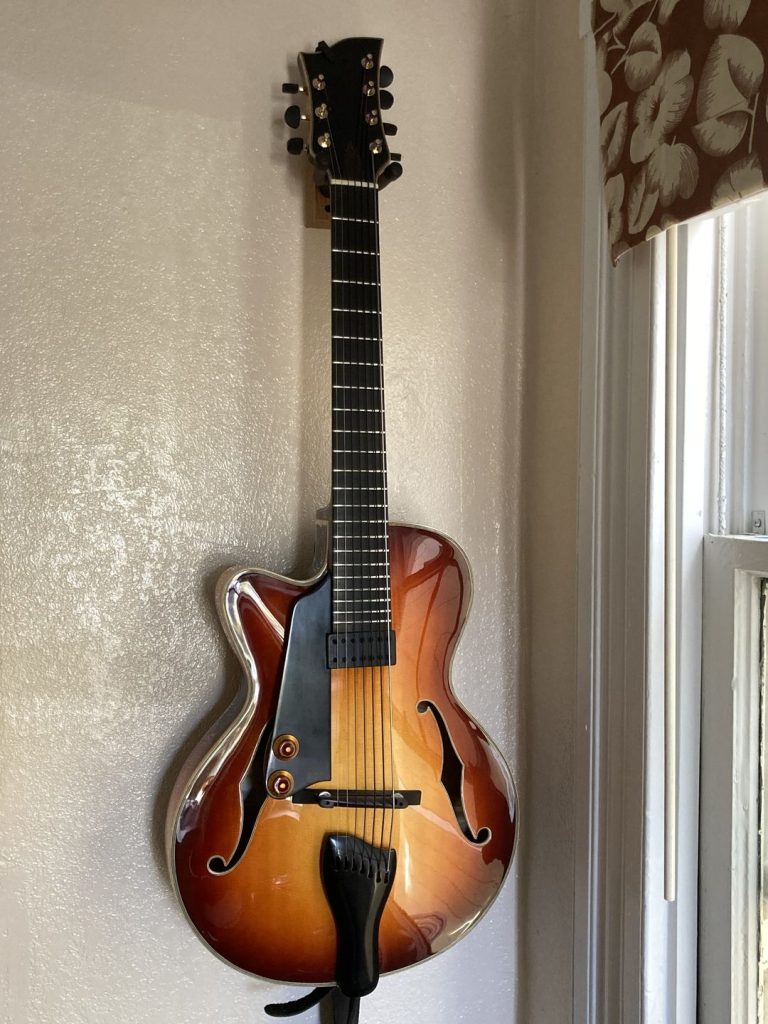
This 7 string hollow solid wood archtop is handmade by Mr Wu, who started making archtops for Eastman, following Benedetto’s method (as opposed to Gibson). He later opened his own shop, and makes custom hand-carved archtops to order. (yolandateam.com).
It is a hollow body thinline design, with x-bracing, and a floating Kent Armstrong hand-wound adjustable 14-pole humbucking pickup mounted to the pickguard. Although this is a solid top acoustic archtop, my original intent was to have a sunken humbucker design, emulating the classic amplified tone of Joe Pass, Jim Hall, Kenny Burrell, etc. The X-bracing prevented this, so I chose the Kent Armstrong floater because he designed it to sound more like a sunken pickup.
The guitar has a shorter scale length (14.75”), in line with the Ibanez 7-string production models, and 50 mm width at the nut. Ebony fretboard, solid spruce top and back, maple sides. Some complain that a short scale length won’t allow for the right intonation with a low A string, but so far I haven’t had a problem (see below for string choices)
Because they didn’t have any production metal tailpieces in lefty, the ebony tailpiece was carved by Mr Wu, and is attached with a metal bracket. My local luthier fashioned a metal plate on the back of the tailpiece, to ground the strings to the rest of the electronics–this is essential, otherwise the amp picks up a lot of noise! I also asked Mr Wu to carve a backup tailpiece, which is set up for a more traditional cable attachment (pictures in doc linked below)
My local luthier who did the finishing job, including electronics and PLEK machine, is Wood Street Guitar Repair in Oakland, CA, and I highly recommend their work.
Hardware: I have kept the Wilkinson tuning machines, which seem to work okay, though not quite as nicely as the Grover or Gotoh tuners I have on other guitars (note on Wilkinson tuners gleaned from online sources: the screw placement is different from Grover, so you’ll have to drill new screw holes. Also, the knobs have a different inside diameter, so you can’t simply switch them out). All other hardware, wiring and pots, cord jack, etc. I had replaced locally with equipment that is worthy of this handmade guitar. The Gibson-style knobs are reverse numbered (lefty, new from an ebay seller) and have a finish that matches the burst color.
Color: I wanted a light, almost honey burst color scheme (D’Aquisto). I sent them a picture from their own website of a color scheme I liked, since it is something I know they could do. It has a subtle red tone that pops in natural daylight, but is muted indoors.
The headstock shape is a nod to the first production 7-string archtop, made by Gretsch under the guidance of George Van Eps (see pic below). Bucky Pizzarelli used this model guitar to develop his unique (fingerstyle) take on 7-string chord melody throughout the 1970’s, before his involvement with Benedetto guitars in the early 1980’s.
Van Eps Gretsch 7 string production archtop:
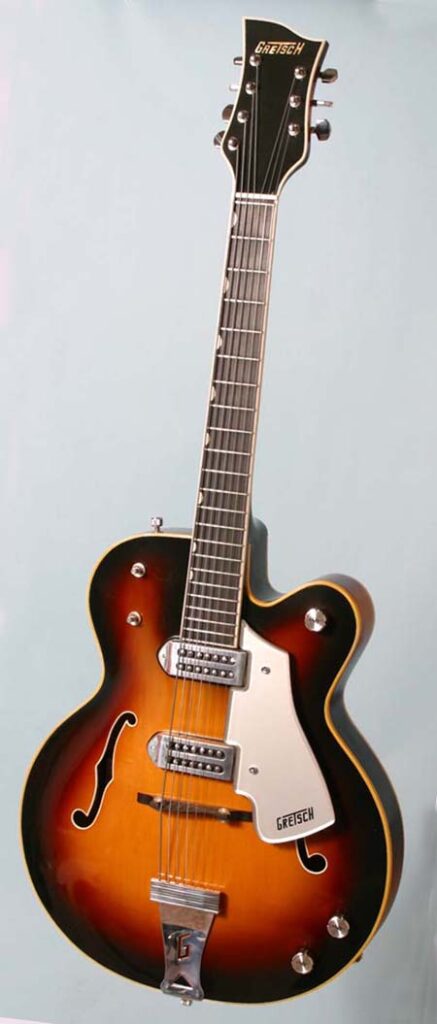
Strings: I use LaBella Jazz tapes (light gauge), which give a uniquely rich sound, while retaining a low tension and ease of playing. I use the lightweight (12-56) 6-string set, with a D’Addario Chrome flatwound (CG075 XL .075) for the low A string. The LaBella 7-string set is heavier gauge, which would have higher tension (though not much, according to users), and the thicker diameter low strings would require more drilling/carving of the nut, tailpiece, and tuning pegs. I play fingerstyle with very low action, which has less impact on the possible intonation problems of a low A on a 24.75″ scale
Amplifier: The search for the perfect jazz sound continues. (and deserves its own web page, coming soon)
please see my youtube page “john piazza music” (link at bottom of page) for some examples of these various amps.
Polytone Mini Brute II
Having spent years (decades!) trying to make Fender-style tube amps less trebl-y, I finally acquired a used Polytone Mini Brute II from the late 1970’s (felt covered, 12″ speaker), and I absolutely love it, especially for fingerstyle playing (think Joe Pass). I will use Polytone amps as long as they last, and as long as I can find people to repair and maintain them. Not only is the speaker warm and cozy, with full bass response, but the high notes and clarity are tempered with just enough softness and texture thanks to the Baxandall circuit, which is also found in old Ampeg amps, as well as vintage solid state hi-fi stereo units (at least that’s what folks who know say it is). Here’s one person’s assessment of the Polytone sound and its causes: “Polytone amps emit a spongy, warm, quite musical sound that comes from the Baxandall tone circuit, plus perhaps, a closed speaker cabinet stuffed with insulation.” (source: http://qrp-popcorn.blogspot.com/2020/11/clean-jazz-guitar-amp-builder-notes.html)
The DV Mark Little Jazz is an affordable low-maintenance take on Polytone, and will satisfy 95% of people who want a classic reliable portable “polytone-adjacent” tone. I’ve seen used ones for as low as $199. I recently brought mine to a loud jam session (drums, piano, vibes and 5 horn players), and it sounded great, and was not lacking in volume. In that particular room, it immediately gave me a contemporary Ben Monder/Pat Metheny sound without any adjustments. On an outdoor duo gig, it gave me a sound that was very close to the 1970’s Joe Pass solo/duet albums. I keep it at work for those days I want to play or host an impromptu jam session at lunch.
My most Lightweight and portable amp setup is a TC Electronics BAM 200 with a Toob Metro BG 6.5 inch speaker. The whole thing weighs about 7 lbs, fits in a literal lunch bag, and is less than half the price of the smallest Henriksen amp. I will often bring it with me as a backup just in case my Polytone runs into trouble (though it hasn’t, knock on wood)
I recently acquired a very inexpensive used second-generation Henriksen JazzAmp 110 from 2006 (with reverb), which is a more portable “updated” version of a polytone. It has a similar sound, and can be even darker than the Polytone. I’m still figuring out the eq settings, but I can see why Polytone users loved it when it first came out.
I plan to post more links about the process of ordering a Wu. The forum on jazzguitar.be has a lot of helpful information about this process, from satisfied customers, so be sure to visit, or google search “jazzguitar” and “Wu”
Detailed pics:
This first image was taken in natural light, and tends to show the subtle reds in the burst (in person it appears more red), while the others are under artificial light.
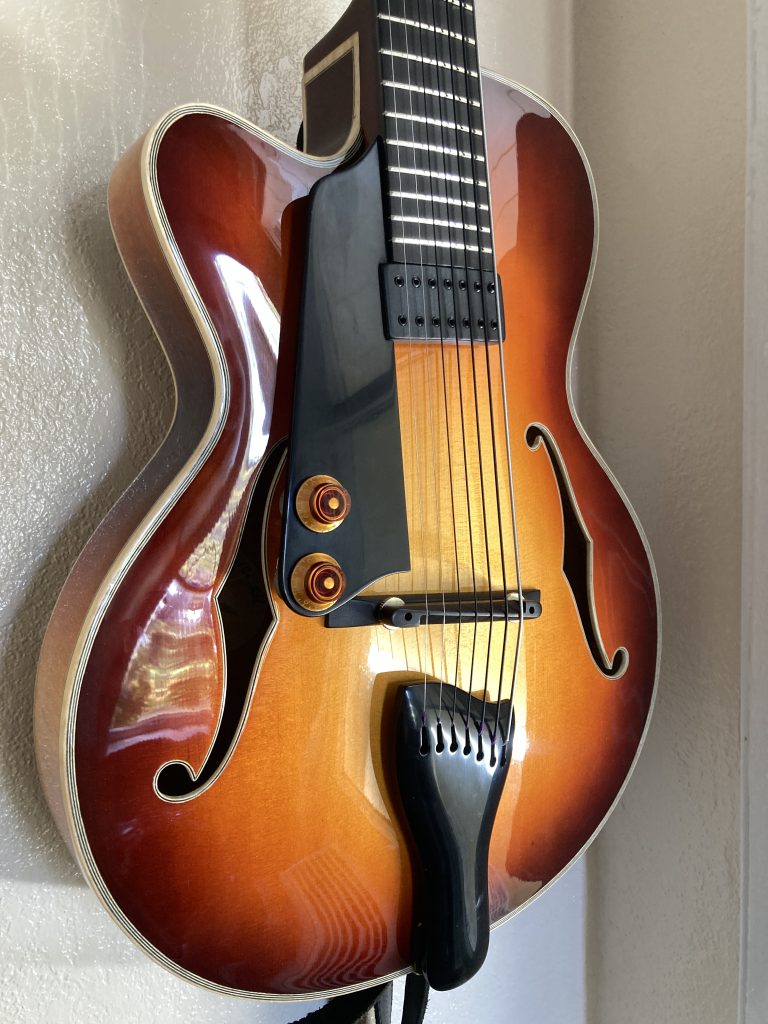
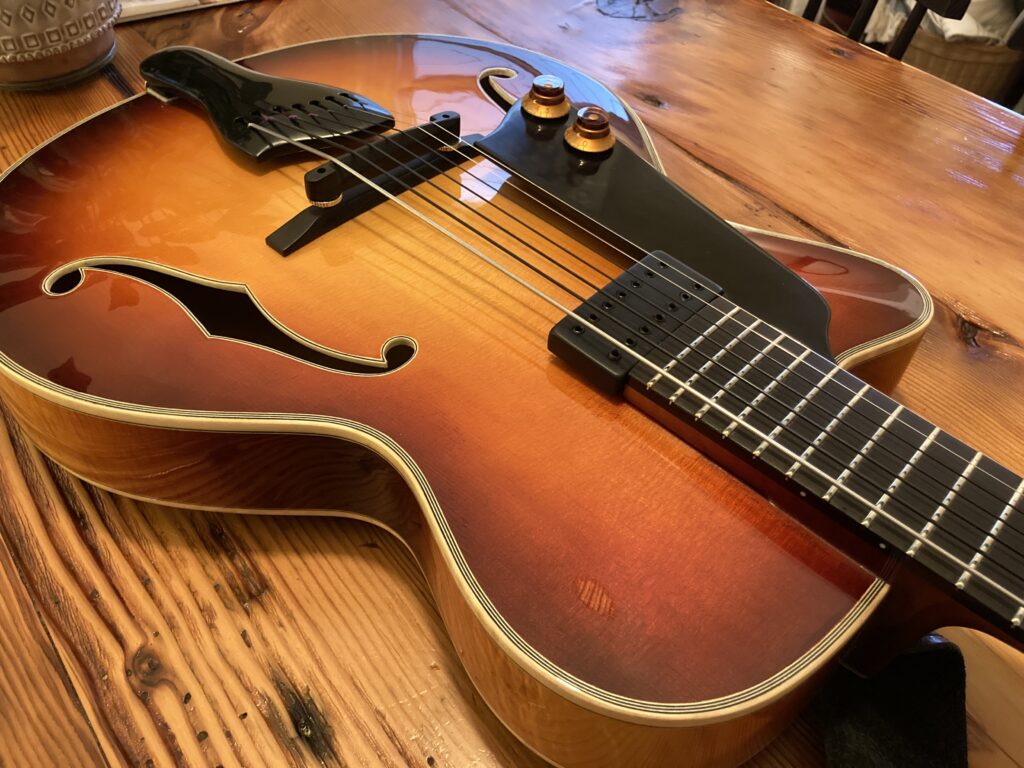
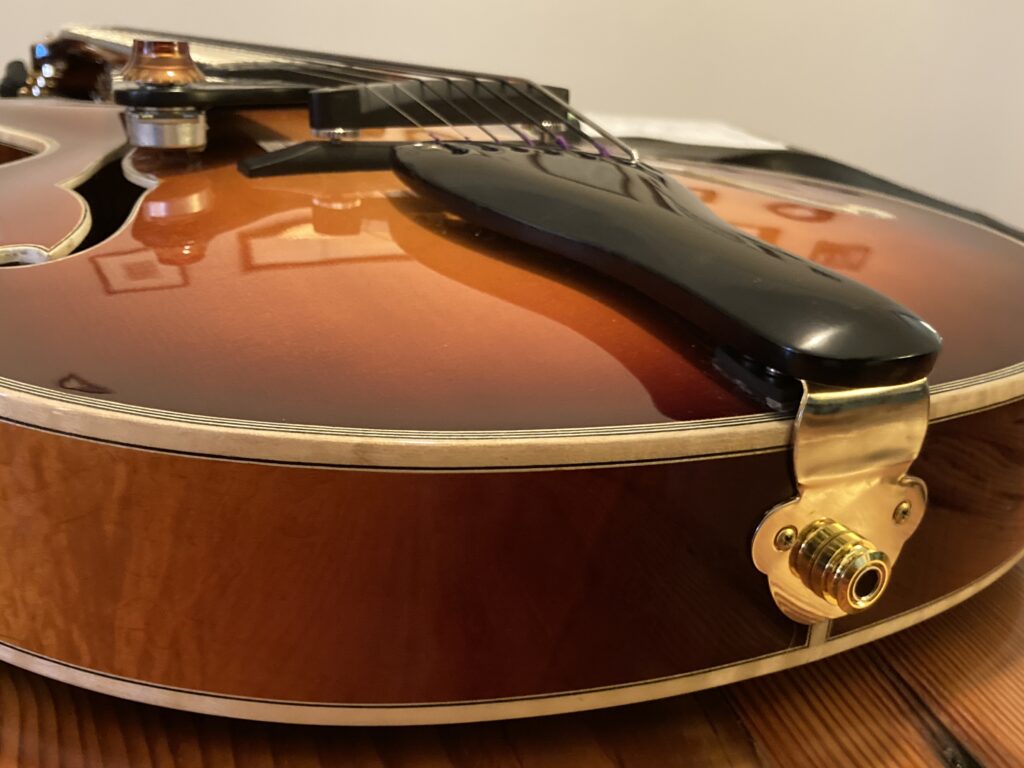
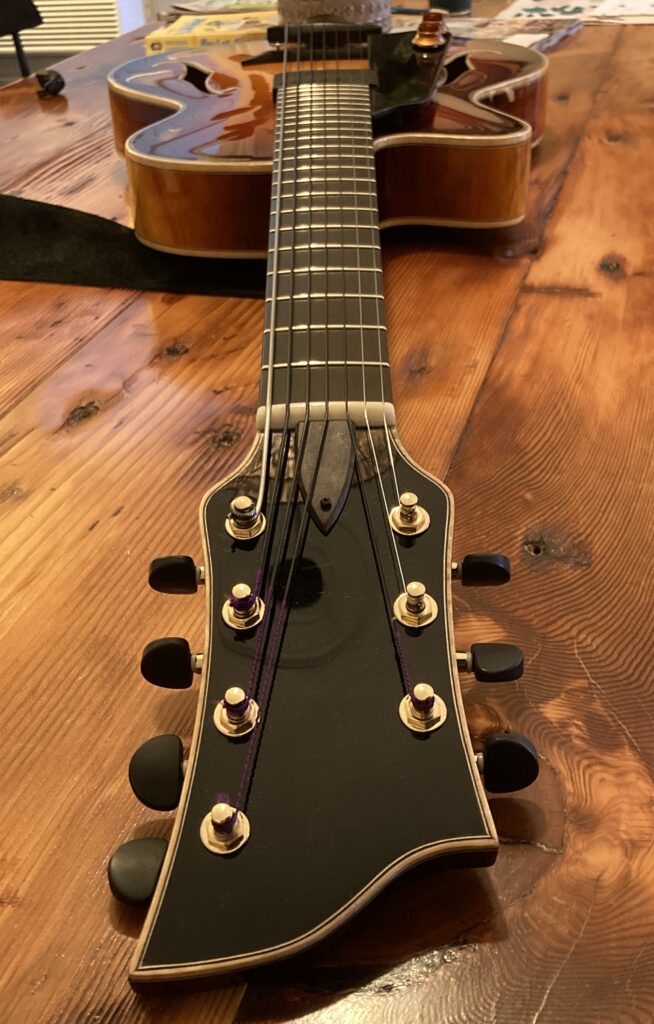
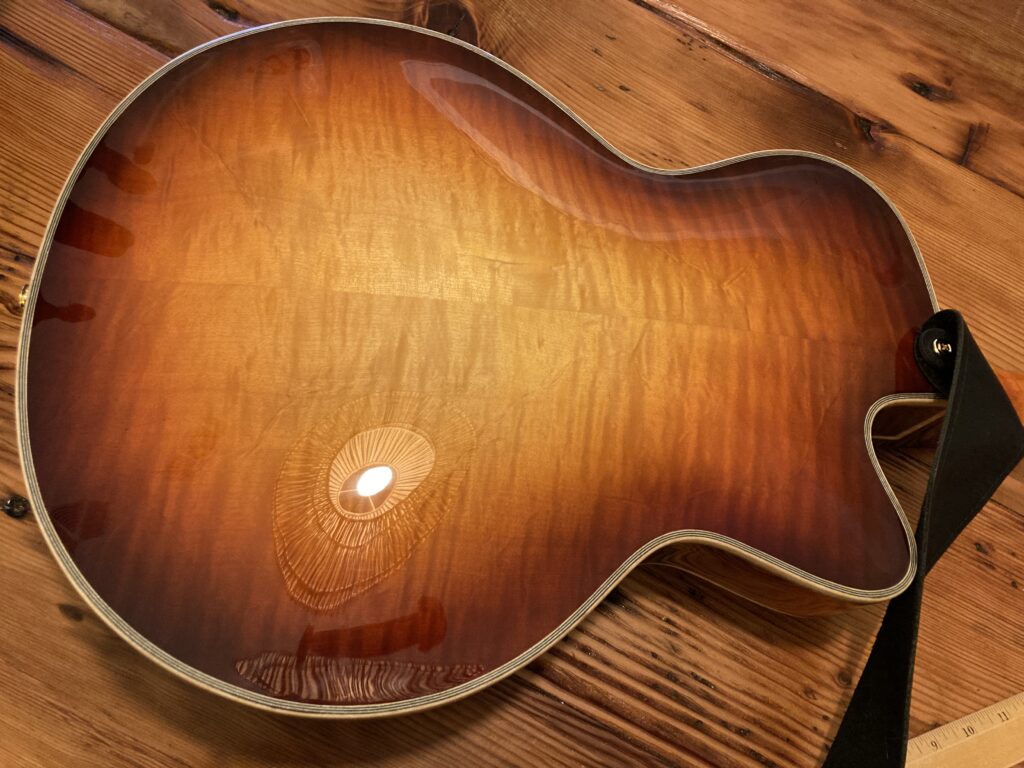
This doc contains pictures and drawings from the beginning of the process.
You can hear this guitar played through a variety of amplifiers on this youtube playlist
https://youtu.be/Aj2sgAXz23Q?si=ppLMpnKBckU4ew-p
This page is all about Bucky Pizzarelli’s fingerstyle playing, which inspired my own 7-string journey
You can read about other Wu owners’ experiences in the Forum of jazzguitar.be
